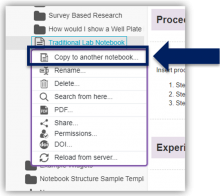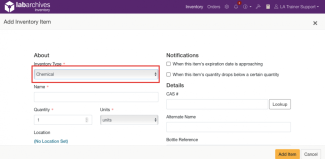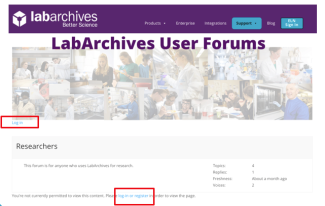
LabArchives® News Archive If you missed the news or want to review an old article, this is the place to be!
Jump to year:
2022
March 25, 2022 - New Inventory List Entry
May 9, 2022 - New UK Sign On Page with Two Factor Authentication
June 13, 2022 - Updates from LabArchives
June 28, 2022 - LabArchives HIPAA Compliance
September 27, 2022 - Notebook and Inventory Updates
September 27, 2022
Notebook and Inventory Updates
Notebook
- Notebook Ownership Transfer Tool Now Available
- Updated Mathematical Equation Entry
Inventory
- Hide empty standard fields
- Bulk update order status
- Unique ID Displays
- Filter for items with no location set
June 28, 2022
The University of Kentucky LabArchives instance is a HIPAA-compliant platform. Notebook owners and administrators are responsible for ensuring that PHI within a notebook is not shared with anyone except for individuals explicitly authorized according to the IRB and Data Use Agreements. This applies to sending exported notebook material and providing shared access to a notebook or notebook pages. (Some verbiage adopted from Weill Cornell Medicine)
Click here for more information about LabArchives security: https://www.labarchives.com/security-compliance/
June 13, 2022
May 9, 2022
New UK Sign On Page with Two Factor Authentication
On Wednesday, May 11, 2022, UK Research will be implementing Two-Factor Log-In for LabArchives. This implementation is to further enhance the cybersecurity posture for our University research community.
The new LabArchives sign on page will look similar to the image below.
You may be prompted for a Push or Passcode from Duo Mobile.
March 25, 2022
Now you can search your Inventory items and list what you use directly in your ERN!
This week LabArchives announced the new Inventory List Entry for your notebooks. This new Entry item will allow more ease of use between your Inventory and your ERN.
For more information and instructions, including a video demonstration, on how to use this new entry, click to view the LabArchives article.
2021
January 15, 2021 - Rich Text Entry Tool
March 11, 2021 - New PubChem Lookup Feature
March 16, 2021 - New Advanced Search for Inventory
July 22, 2021 - LabArchives Important Release Update, Addressing Issues, and User Forum new location
September 23, 2021 - How to allow copying from Notebooks that you own
September 23, 2021
How to allow copying from Notebooks that you own
You are now able to allow copying from notebooks that you own!
Please note: If you choose to allow individuals to copy from your notebooks, you will be responsible for assuring that the data is shared in compliance with any IRB, IACUC, Sponsor or Federal Agency policies.
To allow your Notebook users to copy an entry, page, folder, or notebook that you own to another notebook, you will click the arrow next to your name to reveal the dropdown list. Choose “Manage My Account”.
In the Manage My Account tool, you will see a table showing everyone that has access to at least one of the notebooks that you own. On the right side of the page, you will see a settings icon, click the icon to go to your account settings.
Under Notebook Content Control, you will click the check box next to “Allow copying from my account to notebooks in another account.
For more information, please see the following LabArchives Knowledgebase articles:
6.05 Manage My Account
July 22, 2021
LabArchives Important Release Update, Addressing Issues, and User Forum new location
- New ELN Android App
- Page Signing and Witnessing Feature
- New User Forum Location
March 16, 2021
New Advanced Search for Inventory
LabArchives® Inventory has just released Advanced Search for Inventory – including the ability to search all Custom Fields – a new feature that makes it even easier and faster to find items within your lab’s inventory.
Use Advanced Search to search for items using standard and custom fields for selected inventory types and to:
- Limit searches by Inventory Type, Location, Received Date and Availability.
- Use boolean operators which are presented for each field.
- Save search options to reuse detailed search queries quickly.
If you add custom data fields to your inventory types, Advanced Search enables you to leverage that data in entirely new ways. Use it to quickly retrieve items from your inventory based on discrete and specific search queries and to add detailed item information to lab reports.
To learn more about this new LabArchives® Inventory feature, click here!
March 11, 2021
New PubChem Lookup Feature
Quickly add chemicals to your lab inventory with LabArchives® Inventory’s new PubChem Lookup feature.
This new feature makes it easy to add chemicals, and the essential information associated with them, to your lab’s inventory. To access this new feature:
- Add an Inventory Item.
- Select ‘Chemical’ in the Inventory Type dropdown menu.
- Enter the chemical’s CAS # into the new CAS # field and use the Lookup option.
This will quickly populate key fields like name, molecular weight and formula with data from PubChem. The chemical inventory type now also includes fields for chemical safety and SMILES structure information. Institutional safety forms can be added along with manufacturer SDSs. You can still add, modify and remove fields from the chemical inventory type, other than the fields populated by the PubChem Lookup, to customize information for your lab’s needs.
Use the PubChem Lookup feature to:
- Save time as you add chemicals to your lab inventory.
- Tailor information required for chemical items to your lab’s needs.
- Capture robust information about the chemicals stored in your lab.
- Display hazard information prominently for lab members.
To learn more about this new LabArchives® Inventory feature, click here!
2020
December 16, 2020 - User Forums
December 1, 2020 - Jupyter Notebooks
October 28, 2020 - Data Managemen
December 16, 2020
LabArchives is very excited to announce that they have launched LabArchives User Forum within their website. This forum is a place for LabArchives users to connect, share, ask questions and learn from one another.
Join the conversation by registering for the forum here. Please click the ‘Registration’ tab and submit your details. You will receive a message once you’ve been approved to login. Once you’re logged in, feel free to explore the different discussion boards, submit your own topics, and reply to threads that are already there.
December 1, 2020
LabArchives adds Jupyter Notebooks integration
LabArchives now integrates with Jupyter Notebooks - open-source software with open standards and services for interactive computing across dozens of programming languages. Jupyter files combine live, executable code with narrative text (Markdown), LaTex (equations), images and interactive visualizations on a single page to capture the entire workflow of data science, scientific computing and machine learning projects.
Use this integration to:
- Save time analyzing, documenting and downloading Jupyter files.
- Eliminate the need to save separate .html versions of Jupyter files.
- View Jupyter files on the same page as procedures and other project meta-data.
- View Jupyter files’ revision histories with LabArchives' "view revisions" function.
The Jupyter - LabArchives integration enables users to capture their workflows in ways not before possible. By importing Jupyter Notebook files (.ipynb files), users can include the work those files contain as part of their observations contained in LabArchives notebooks. Users no longer need to open these files in Jupyter separately to view their content. The integrated Jupyter files are displayed inside LabArchives ELN as a thumbnail, and can be opened and reviewed with a single click.
To learn more about this integration, click here!
October 28, 2020
Data Management, Research
Breaking down vaccine development with an assay expert
Published by Olivia Sisson
Maria Dennis, a research analyst in the Permar Lab at Duke University Medical School, is developing vaccines that prevent the spread of HIV from mother to child during the perinatal period.
These days Maria and her team work in shifts, only coming into the lab when absolutely necessary. When she does go into the lab, Maria runs experiments, records data in LabArchives and then returns home to analyze it all online. The Permar lab has quickly adapted to this new landscape and, at the same time, the work that they do has become even more relevant. Read more...








